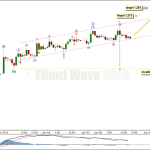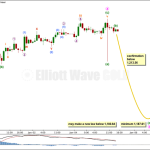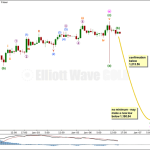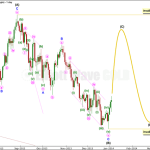GOLD Elliott Wave Technical Analysis – 6th January, 2013 | Lara …
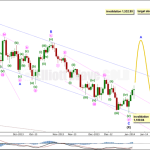
GOLD Elliott Wave Technical Analysis – 6th January, 2013
By:
| Mon, Jan 6, 2014
In last analysis both hourly wave counts expected more upwards movement which
is what happened. However, upwards movement was followed by a sharp spike below
1,227.11. The targets were not reached.
It is at this point the hourly wave counts diverge.
Gold is still within a large fourth wave correction at primary wave degree
which is incomplete. To see a full explanation of my reasoning for expecting
that primary wave 4 is not over and is continuing see this.
Movement above 1,277.97 would provide confirmation that primary wave 4 is
not over. At that stage upwards movement could not be a fourth wave correction
within primary wave 5 because it would be in its first wave price territory,
and the downwards movement labeled intermediate wave (X) would be confirmed
as a completed three wave structure.
Primary wave 2 was a rare running flat correction, and was a deep 68% correction
of primary wave 1. In order to show alternation in structure primary wave 4
may be a zigzag, double zigzag, combination, triangle or even an expanded or
regular flat. We can rule out a zigzag because the first wave subdivides as
a three. This still leaves several structural possibilities.
The downwards wave labeled intermediate wave (X) is now 99% the length of
the upwards wave labeled intermediate wave (W). Primary wave 4 is most likely
to be a combination or triangle in order to show structural alternation with
the running flat of primary wave 2.
Primary wave 4 is less likely to be a flat correction because if it were it
would be a regular flat. These have similar behaviour and a similar look to
running flats, and so there would be little structural alternation between
primary waves 2 and 4.
Draw a parallel channel about minor wave C downwards (pink channel) with the
first trend line from the highs labeled minute waves ii to iv, then place a
parallel copy upon the low labeled minute wave iii. When this channel is clearly
breached by upwards movement with a full daily candlestick above the channel
and not touching the upper trend line, then we shall have trend channel confirmation
that minor wave C is complete and the next wave is underway.
When the channel about intermediate wave (X) is finally breached by upwards
movement then I would consider that final confirmation that intermediate wave
(Y) is underway.
Primary wave 4 is most likely to be a combination rather than a double zigzag
because of the depth of intermediate wave (X). Double combinations take up
time and move price sideways, and their X waves can be very deep. Double zigzags
are different because their purpose is to deepen a correction when the first
zigzag does not move price deep enough, so their X waves are not normally very
deep. Thus intermediate wave (Y) is most likely to be a flat correction, and
less likely a triangle and least likely a zigzag. It is most likely to end
about the same level as intermediate wave (W) at 1,434 so that the whole structure
moves sideways. It may last about 43 to 89 days, depending upon what structure
it takes.
If intermediate wave (Y) is a flat correction then within it minor wave B
must retrace a minimum of 90% the length of minor wave A, and it may make a
new low below 1,180.84. This invalidation point will only apply while minor
wave A is incomplete.
If intermediate wave (Y) is a flat correction then within it minor wave A
must subdivide as a three wave structure. This is most likely to be a zigzag,
but it may also be a flat correction (or a double). It may not be a triangle.
The main hourly wave count looks at the most likely structure of a zigzag.
The alternate hourly wave count will look at the next likely structure of a
flat correction. The new second alternate hourly wave count will look at the
possibilities of a combination or double zigzag.
Primary wave 4 may not move into primary wave 1 price territory. This wave
count is invalidated with movement above 1,532.90.
Main Hourly Wave Count.
Minor wave A has most likely begun and is most likely unfolding as a zigzag,
subdividing 5-3-5. This main hourly wave count has the highest probability
of all three hourly wave counts because it expects the most common structure
to unfold.
Within minute wave a of the zigzag the structure can only be an impulse or
a leading diagonal. The most likely structure is an impulse.
Upwards movement labeled subminuette wave i is very difficult to analyse.
The only thing for certain is this movement is over because the sharp spike
labeled subminuette wave ii retraced almost all of this slow upwards movement.
Subminuette wave i can only be one of two structures, an impulse or a leading
diagonal. It does not look at all like a diagonal and does not subdivide as
one. It does subdivide as an impulse, although within it there is a problem
of proportion between minuscule waves 2 and 4 within the middle of the third
wave.
Ratios within subminuette wave i are: there is no Fibonacci ratio between
micro waves 3 and 1, and micro wave 5 is 0.46 short of equality with micro
wave 1.
Because the spike labeled subminuette wave ii moved price back into minuette
wave (i) territory it cannot be minuette wave (iv), and so minuette wave (iii)
must be incomplete.
At 1,272 subminuette wave iii would reach 1.618 the length of subminuette
wave i. This target may be reached within a day.
At 1,293 minuette wave (iii) would reach 1.618 the length of minuette wave
(i). This target may be two to three days away.
On the five minute and one minute charts it is unclear if the sharp spike
of subminuette wave ii is a three or a five wave structure; the movement was
so swift the subdivisions within it are difficult to see. If it is a five then
only wave A within subminuette wave ii would be complete. If subminuette wave
ii moves further sideways and a little lower it may not move beyond the start
of subminuette wave i. This wave count is invalidated with movement below 1,213.56.
Alternate Hourly Wave Count.
If minor wave A is subdividing as a three wave structure then it may be unfolding
as a flat correction. Within the flat correction minute wave a is a completed
three, and minute wave b must also subdivide as a three. Within a flat correction
minute wave b must retrace a minimum of 90% the length of minute wave a so
must reach down to 1,187.61.
If the flat correction of minor wave A is an expanded flat then minute wave
b would reach down to 1,177.46 or below. A new low below 1,180.84 is entirely
possible for this wave count.
Minute wave a lasted three days. I would expect minute wave b to be a minimum
duration of three days, and maybe five days. B waves are often more time consuming.
If price moves below 1,213.56 within the next 24 hours then I would use this
alternate and the second alternate below.
Second Alternate Hourly Wave Count.
If minor wave A is subdividing as a three wave structure then it may also
be unfolding as a double combination or double zigzag. Within the double the
first structure labeled minute wave w is a zigzag.
Minute wave x should be a three in the opposite direction. X waves do not
have a minimum requirement in relation to the length of W waves, and there
is no minimum price point to the downside. X waves also have no maximum length,
and minute wave x may make a new low below the start of minute wave w at 1,180.84.
X waves are most commonly zigzags (almost all the time, this is very common),
but they may subdivide into any corrective structure.
X waves are most often more brief than W, Y and Z waves. Minute wave w lasted
three days, and minute wave x would be expected to be over within two or three
days.
Alternate Daily Wave Count – Triangle.
It is also possible that primary wave 4 may continue as a regular contracting
(or barrier) triangle.
The expected direction of this next upwards wave is the same, but for this
alternate intermediate wave (C) of the triangle may not move beyond the end
of intermediate wave (A). The triangle is invalidated with movement above 1,438.83.
Intermediate wave (C) must unfold as either a single or double zigzag. Within
it no second wave correction, nor wave B of the zigzag, may move beyond the
start of the first wave or A wave. This wave count is invalidated with movement
below 1,180.84.
The final intermediate wave (E) upwards may not move above the end of intermediate
wave (C) for both a contracting and barrier triangle. E waves most commonly
end short of the A-C trend line.
All five subwaves of a triangle must divide into corrective structures. If
this next upwards movement subdivides as a zigzag which does not make a new
high above 1,438.83 then this alternate would be correct.
Triangles take up time and move price sideways. If primary wave 4 unfolds
as a triangle then I would expect it to last months rather than weeks.
Please enable JavaScript to view the comments powered by Disqus.
Author: Lara Iriarte
Lara Iriarte
elliottwavegold.com
Elliott wave is one of the more difficult and complicated technical analysis
tools. When done right it can be uncannily accurate.
I have been using the Elliott wave principle to analyse up to five markets
a day since 2008. I began Elliott Wave Forex (originally ForexInfo.us) in
2009 to provide daily analysis of EURUSD and GBPUSD, then I began Elliott
Wave Stock Market in 2010. Elliott Wave Gold began in August, 2013. Currently
I provide daily analysis of Gold on this site, and daily analysis of the
S&P 500 on Elliott Wave Stock Market for its members.
I have a science background (BSc) which has trained me to think logically
and be evidence focussed. Over the years I have seen no market movement which
does not fit into the clear and restrictive rules for Elliott wave structures.
I have members who are fund managers, institutional investors and professional
traders.
If you want to learn how to apply the Elliott wave principle to any market
my analysis service is designed to teach you, daily, how to do this.
Copyright © 2013-2014 Lara Iriarte
All Images, XHTML Renderings, and Source Code Copyright © Safehaven.com
Visit site:
GOLD Elliott Wave Technical Analysis – 6th January, 2013 | Lara …
See which stocks are being affected by Social Media


